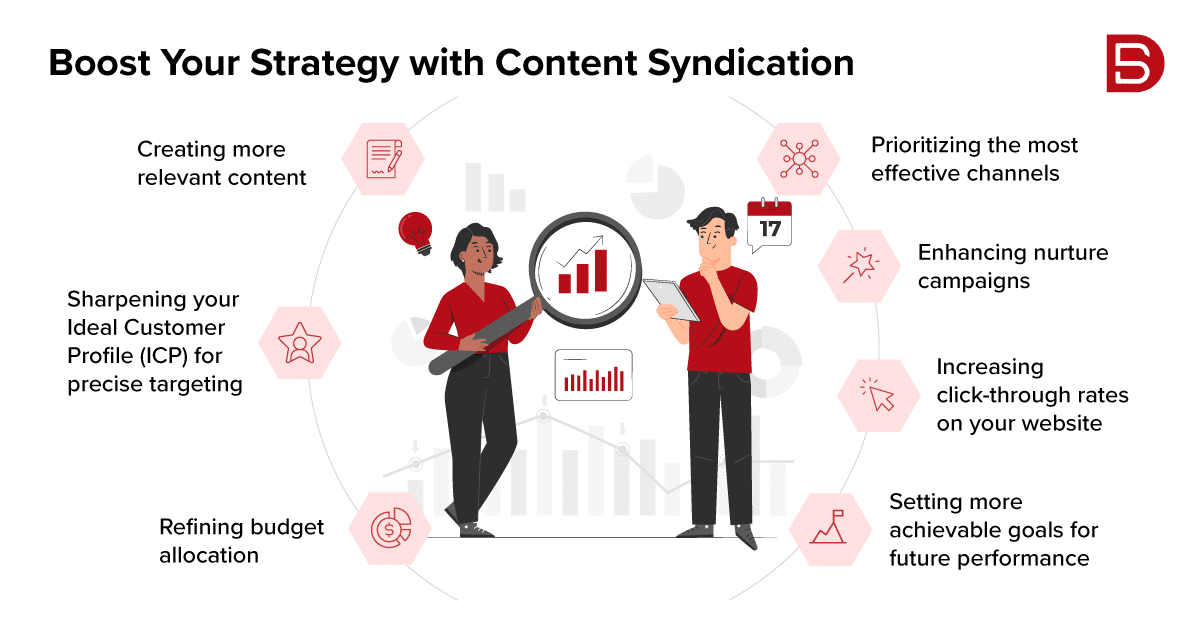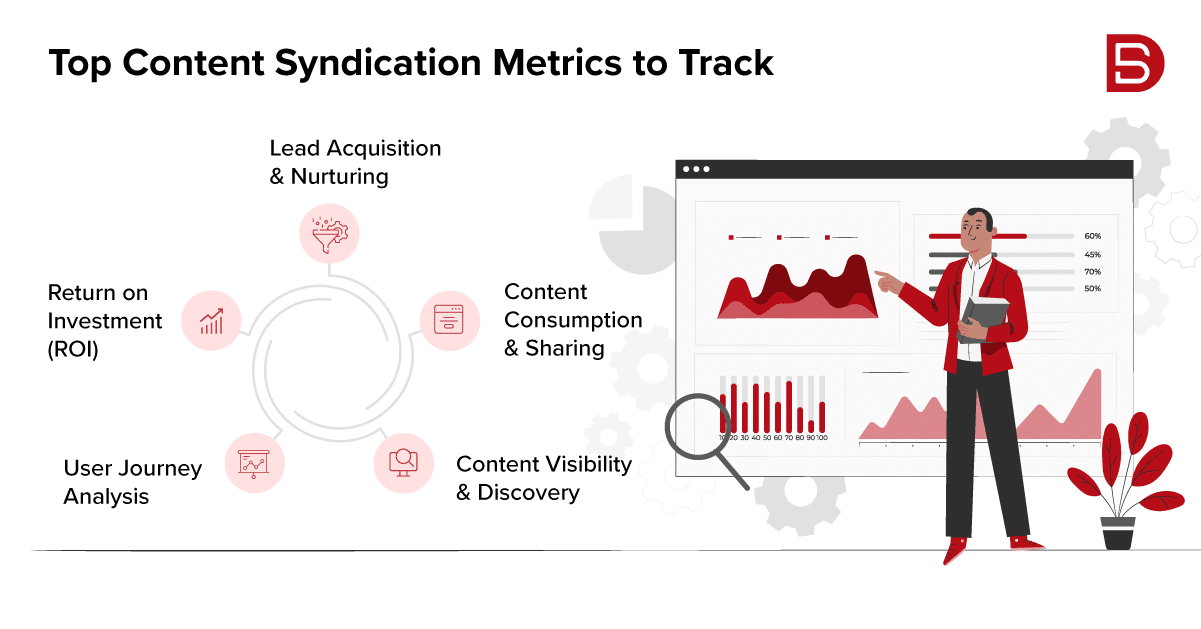Does content syndication work? It sure does. But without the right metrics, you’ll never know how far your campaigns are going. You need to understand how your content performs, where your audience is engaging, and which channels give you the best results.
The idea behind B2B content syndication is simple:
- Take your best content.
- Share it with a larger audience.
- Ramp up your lead generation.
But when you get into it, you’ll see that the success of a content syndication campaign is more than just the leads. It’s also about the engagement it sparks and the valuable web traffic it brings in.
So, let’s take a closer look at these important performance metrics, understand why they matter, and figure out how you can use them to make your future content syndication efforts even better.
Why It's Crucial to Track Content Syndication Performance
Tracking content syndication isn’t just about crunching ROI numbers but maximizing your return. By analyzing insights from each campaign, you can continuously improve and boost your ROI over time.
Monitoring performance helps you get the most out of your B2B content syndication efforts. You can see what’s working and what isn’t, allowing you to scale successful strategies and minimize ineffective ones. For example, by examining how leads interact with your content across different channels, you can pinpoint which types of content drive the most engagement, attract high-quality leads, and convert more customers. Additionally, you can see which content resonates best with your audience and which platforms your ideal buyers prefer.
This insight lets you fine-tune your content strategy to achieve even better results in your next content syndication campaign. Here are a few areas you can improve using what you’ve learned from B2B content syndication metrics:
Top Content Syndication Metrics You Need to Track
Measuring your content syndication performance is key to making smart, data-driven decisions and optimizing your strategy. It helps ensure your content reaches the right audience and drives your desired results. However, picking the right metrics depends on your goal and the content types you share.
For example, if your goal is to boost brand awareness, you’ll want to focus on top-funnel content that’s broad and engaging, with thoughtful industry insights. Set your KPIs around this goal, tracking metrics like impressions and click-through rates (CTR) on platforms like YouTube and LinkedIn. In short, ensure the data you track aligns with your campaign objectives.
Here are some key metrics to focus on to track and improve your content syndication performance, particularly for B2B lead generation:
1. Lead Acquisition & Nurturing
While generating leads is often the goal, assessing their quality is crucial too. Higher-quality leads are more likely to convert into valuable marketing revenue. By figuring out which content brings in the best leads and seeing how they turn into customers, you can tweak your future campaigns for even better results.
Here’s how to look at these metrics, whether for individual campaigns or over time:
- Lead Volume: The total number of leads your content syndication campaign generates.
- Lead Quality: The percentage of marketing-qualified leads (MQLs) or sales-qualified (SQLs) leads.
- Conversion Rate: The percentage of leads that eventually become customers.
- Sales Cycle Length: The average time for a lead to go from first engagement to a closed sale.
By diving into these metrics, you can refine your approach and boost the quality of your leads, making your content syndication efforts even more effective.
2. Content Consumption & Sharing
Knowing what resonates with your audience is key to figuring out how they interact with your content. When people click on your ads, download eBooks, or share your posts, it shows they’re genuinely interested. This can help you spot potential marketing-qualified leads (MQLs).
Engagement metrics also offer clues about where prospects are in their buying journey. For instance, if someone fills out a form to get a white paper, they’re likely in the mid-stages and looking for more detailed info about your business. This means you’re dealing with a serious lead, and your sales team can tailor their approach accordingly.
Here are some key metrics to track to understand your audience’s engagement with your content:
- Asset Downloads: How often is your content downloaded.
- Form Fills: The number of times people complete a form to access gated content.
- Webinar Registrations: How many people sign up for your webinars.
Webinar Attendance: - The number of people who attend your webinars.
- Video View Completion Rates: How long people watch your videos on average.
- Social Media Shares: How often is your content shared on social media.
- Email Forwards: How often your content is forwarded via email (using the “forward to a friend” option can give you a clearer picture).
- Amplification Rate: The percentage of shares compared to your total number of followers (shares divided by followers, multiplied by 100). This helps you see how your content is performing across different platforms.
3. Content Visibility & Discovery
You need to cast a wide net with your content syndication efforts to excel in lead generation. Tracking the right reach metrics helps you find the best channels and audience segments to support your goals. Here are key metrics to monitor:
- Total Impressions: How many times your content is displayed on screen.
- Web Traffic: The count of unique and repeat visitors to your website.
- Newsletter Subscribers: Number of prospects who sign up for your newsletter.
- Podcast Listeners: Number of prospects who listen to your podcast.
- Social Network Followers: Total followers across your social media channels.
- Publication Readership: Average reader number per content piece.
4. User Journey Analysis
Engagement is crucial, but seeing how well your content keeps prospects interested is important. If you notice a drop in page views or an increase in bounce rates, it may be time to refine your content strategy.
Reviewing user behavior metrics helps you determine if your landing pages need better keywords, more compelling offers, or a site redesign for a better user experience. Here are key metrics to assess:
- Bounce Rates: The percentage of visitors who leave your site after viewing just one page.
- Page Views: The total number of views on your website or landing page.
- Average Time on Page: How long users spend on a specific page or content.
- Pages per Session: The average number of pages users view during a single visit.
- Scroll Depth: How far down a page visitors scroll to continue reading.
If your metrics show that visitors are spending a lot of time on your page, scrolling to the bottom, and clicking through to more content, you’ve successfully executed an effective content strategy.
5. Return on Investment (ROI)
When it comes to content syndication, understanding the financial impact is key. Here is the key metric to track-
Cost-per-Lead (CPL): This tells you how much you spend to acquire each lead. This is especially important if you’re working with a paid content syndication vendor. Together, you can set a guaranteed CPL based on your audience and budget, so you know exactly what you’re spending and what to expect. Paid vendors often use data-driven methods to deliver faster and more effective results, giving you more value for your investment.
To find your optimal CPL, just divide your total content syndication spend by the average number of leads you’ve generated from recent campaigns. This will help you set a more accurate CPL target with your vendor.
Whether you’re managing content syndication in-house or partnering with a vendor, measuring ROI is crucial. It helps you see if your investment is paying off. So, crunch the numbers and see how your efforts are stacking up.
Conclusion
By evaluating metrics like generated leads, CPL, and conversions and comparing these with your total investment; whether its time spent creating content or working with a vendor, you’ll get a clear view of how valuable your content syndication efforts are. A strong ROI not only highlights the success of your current strategy but also makes a compelling case for increasing your budget to drive even better results

Paul van de Kamp




